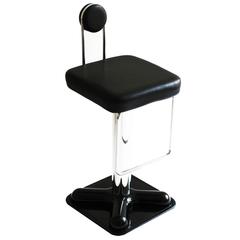Joe Colombo Birillo
Recent Sales
Vintage 1970s Italian Stools
Metal
Vintage 1970s Italian Modern Stools
Metal
Vintage 1970s Italian Stools
Steel
Vintage 1970s Italian Space Age Stools
Chrome
Vintage 1970s Italian Mid-Century Modern Stools
Chrome
Vintage 1970s Italian Stools
Chrome, Steel
Vintage 1970s Italian Mid-Century Modern Benches
Metal, Steel
Vintage 1970s Italian Stools
Stainless Steel
Vintage 1970s Space Age Stools
Metal, Chrome
Vintage 1970s Italian Space Age Stools
Metal, Chrome
Vintage 1970s Italian Stools
Mid-20th Century Italian Mid-Century Modern Stools
Chrome
Vintage 1970s Italian Modern Stools
Steel, Chrome
20th Century Italian Stools
Metal, Steel
Vintage 1970s Italian Stools
Metal, Steel
Vintage 1970s Italian Mid-Century Modern Stools
Steel
Mid-20th Century Italian Mid-Century Modern Stools
Steel
Vintage 1970s Italian Mid-Century Modern Stools
Chrome
Vintage 1970s Italian Mid-Century Modern Stools
Metal
Vintage 1970s Italian Post-Modern Stools
Steel, Chrome
Late 20th Century Italian Mid-Century Modern Stools
Chrome
Vintage 1970s Italian Stools
Stainless Steel
Vintage 1970s Italian Mid-Century Modern Tables
21st Century and Contemporary Italian Stools
Stainless Steel
Vintage 1970s Italian Modern Stools
Vintage 1970s Italian Mid-Century Modern Stools
Vintage 1970s Italian Mid-Century Modern Stools
Stainless Steel, Steel
Joe Colombo Birillo For Sale on 1stDibs
How Much is a Joe Colombo Birillo?
Joe Colombo for sale on 1stDibs
He died tragically young, and his career as a designer lasted little more than 10 years. But through the 1960s, Joe Colombo proved himself one of the field’s most provocative and original thinkers, and he produced a remarkably large array of innovative chairs, table lamps and other lighting and furniture as well as product designs. Even today, the creations of Joe Colombo have the power to surprise.
Cesare “Joe” Colombo was born in Milan, the son of an electrical-components manufacturer. He was a creative child — he loved to build huge structures from Meccano pieces — and in college he studied painting and sculpture before switching to architecture.
In the early 1950s, Colombo made and exhibited paintings and sculptures as part of an art movement that responded to the new Nuclear Age, and futuristic thinking would inform his entire career. He took up design not long after his father fell ill in 1958, and he and his brother, Gianni, were called upon to run the family company.
Colombo expanded the business to include the making of plastics — a primary material in almost all his later designs. One of his first, made in collaboration with his brother, was the Acrilica table lamp (1962), composed of a wave-shaped piece of clear acrylic resin that diffused light cast by a bulb concealed in the lamp’s metal base. A year later, Colombo produced his best-known furniture design, the Elda armchair (1963): a modernist wingback chair with a womb-like plastic frame upholstered in thick leather pads.
Portability and adaptability were keynotes of many Colombo designs, made for a more mobile society in which people would take their living environments with them. One of his most striking pieces is the Tube chair (1969). It comprises four foam-padded plastic cylinders that fit inside one another. The components, which are held together by metal clips, can be configured in a variety of seating shapes (his Additional Living System seating is similarly versatile).
Vintage Tube chairs generally sell for about $9,000 in good condition; Elda chairs for about $7,000. A small Colombo design such as the plastic Boby trolley — an office organizer on wheels, designed in 1970 — is priced in the range of $700.
As Colombo intended, his designs are best suited to a modern decor. If your tastes run to sleek, glossy Space Age looks, the work of Joe Colombo offers you a myriad of choices.
Find vintage Joe Colombo lamps, seating and other furniture for sale on 1stDibs.
Finding the Right Stools for You
Stools are versatile and a necessary addition to any living room, kitchen area or elsewhere in your home. A sofa or reliable lounge chair might nab all the credit, comfort-wise, but don’t discount the roles that good antique, new and vintage stools can play.
“Stools are jewels and statements in a space, and they can also be investment pieces,” says New York City designer Amy Lau, who adds that these seats provide an excellent choice for setting an interior’s general tone.
Stools, which are among the oldest forms of wooden furnishings, may also serve as decorative pieces, even if we’re talking about a stool that is far less sculptural than the gracefully curving molded plywood shells that make up Sōri Yanagi’s provocative Butterfly stool.
Fawn Galli, a New York interior designer, uses her stools in the same way you would use a throw pillow. “I normally buy several styles and move them around the home where needed,” she says.
Stools are smaller pieces of seating as compared to armchairs or dining chairs and can add depth as well as functionality to a space that you’ve set aside for entertaining. For a splash of color, consider the Stool 60, a pioneering work of bentwood by Finnish architect and furniture maker Alvar Aalto. It’s manufactured by Artek and comes in a variety of colored seats and finishes.
Barstools that date back to the 1970s are now more ubiquitous in kitchens. Vintage barstools have seen renewed interest, be they a meld of chrome and leather or transparent plastic, such as the Lucite and stainless-steel counter stool variety from Indiana-born furniture designer Charles Hollis Jones, who is renowned for his acrylic works. A cluster of barstools — perhaps a set of four brushed-aluminum counter stools by Emeco or Tubby Tube stools by Faye Toogood — can encourage merriment in the kitchen. If you’ve got the room for family and friends to congregate and enjoy cocktails where the cooking is done, consider matching your stools with a tall table.
Whether you need counter stools, drafting stools or another kind, explore an extensive range of antique, new and vintage stools on 1stDibs.

